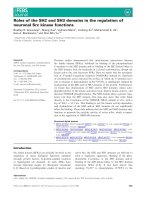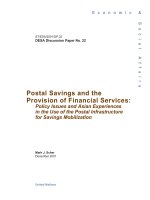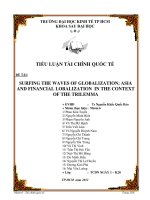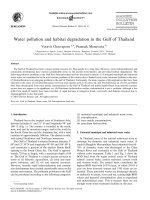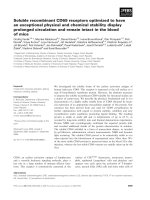- Trang chủ >>
- Khoa Học Tự Nhiên >>
- Vật lý
Quantum chance and non locality; probability and non locality in the interpretations of quantum mechanics
Bạn đang xem bản rút gọn của tài liệu. Xem và tải ngay bản đầy đủ của tài liệu tại đây (6.76 MB, 265 trang )
This book examines in detail two of the fundamental questions raised by
quantum mechanics. Is the world indeterministic? Are there connections
between spatially separated objects?
In the first part of the book after outlining the formalism of quantum
mechanics and introducing the measurement problem, the author examines
several interpretations, focusing on how each proposes to solve the measurement problem and on how each treats probability. In the second part,
the author argues that there can be non-trivial relationships between probability (specifically, determinism and indeterminism) and non-locality in an
interpretation of quantum mechanics. The author then reexamines some of
the interpretations of part one of the book in the light of this argument,
and considers how they fare with regard to locality and Lorentz invariance.
One of the important lessons that comes out of this discussion is that any
examination of locality, and of the relationship between quantum mechanics
and the theory of relativity, should be undertaken in the context of a detailed
interpretation of quantum mechanics.
The book will appeal to anyone with an interest in the interpretation of
quantum mechanics, including researchers in the philosophy of physics and
theoretical physics, as well as graduate students in those fields.
Quantum chance and non-locality
Probability and non-locality in the interpretations of quantum mechanics
Quantum chance and non-locality
Probability and non-locality in the
interpretations of quantum mechanics
W. Michael Dickson
Indiana University
m
w
CAMBRIDGE
UNIVERSITY PRESS
PUBLISHED BY THE PRESS SYNDICATE OF THE UNIVERSITY OF CAMBRIDGE
The Pitt Building, Trumpington Street, Cambridge, United Kingdom
CAMBRIDGE UNIVERSITY PRESS
The Edinburgh Building, Cambridge CB2 2RU, UK
40 West 20th Street, New York NY 10011-4211, USA
477 Williamstown Road, Port Melbourne, VIC 3207, Australia
Ruiz de Alarcon 13, 28014 Madrid, Spain
Dock House, The Waterfront, Cape Town 8001, South Africa
© Cambridge University Press 1998
This book is in copyright. Subject to statutory exception
and to the provisions of relevant collective licensing agreements,
no reproduction of any part may take place without
the written permission of Cambridge University Press.
First published 1998
First paperback edition 2005
Typeset in lOpt Monotype Times
A catalogue record for this book is available from the British Library
Library of Congress cataloguing in publication data
Dickson, William Michael, 1968Quantum chance and non-locality : probability and non-locality in
the interpretations of quantum mechanics / W. Michael Dickson.
p. cm.
Includes bibliographical references and index.
ISBN 0 521 58127 3 hardback
1. Quantum theory. 2. Physics—Philosophy.
3. Determinism (Philosophy). 4. Chance. I. Title.
QC174.12.D53 1998
530.12-dc21 97-8813 CIP
ISBN 0 521 58127 3 hardback
ISBN 0 521 61947 5 paperback
to my parents
Contents
Preface
Acknowledgement
1
1.1
1.1.1
1.1.2
1.2
1.2.1
1.2.2
1.2.3
1.3
1.3.1
1.3.2
1.3.3
2
2.1
2.2
2.2.1
2.2.2
2.3
2.3.1
2.3.2
2.3.3
2.3.4
2.4
xix
Part one: Quantum chance
Quantum probability and the problem of interpretation
Quantum probability and quantum mechanics
The formalism of quantum probability theory
From quantum probability to quantum mechanics
Interpreting quantum mechanics
The 'measurement problem'
Are the quantum probabilities epistemic?
Fable: A brief history of Born's rule
Options for interpretation
The eigenstate-eigenvalue link
Determinism and indeterminism
The lay of the land
Orthodox theories
How is orthodoxy possible?
The projection postulate
Collapse as an analogue of Liider's rule
The projection postulate and its problems
The continuous spontaneous localization (CSL) theory
Intuitive introduction to CSL
CSL as a modification of the Schrodinger equation
Physical clarification of CSL
Does CSL describe our experience?
Probabilities in orthodox interpretations
IX
1
3
3
3
8
9
9
10
14
18
18
19
22
24
24
24
24
28
31
31
32
34
36
42
x
Contents
3
3.1
3.1.1
3.1.2
3.2
3.2.1
3.2.2
3.3
3.3.1
3.3.2
3.3.3
3.4
3.5
4
4.1
4.1.1
4.1.2
4.1.3
4.2
4.2.1
4.2.2
4.2.3
4.2.4
4.2.5
4.2.6
4.3
5
5.1
5.2
5.2.1
5.2.2
5.2.3
5.3
5.3.1
5.3.2
5.4
No-collapse theories
The bare theory
The basic idea
Objections to the bare theory
The many worlds and many minds interpretations
The central idea
Many minds
The consistent histories approach
The formalism of consistent histories
Interpretation of the formalism
Is the consistent histories approach satisfactory?
What is 'interpretive minimalism' and is it a virtue?
Probabilities in no-collapse interpretations
Modal interpretations
The quantum logic interpretation
The basic idea
The Kochen-Specker theorem and quantum logic
Further challenges for the quantum logic interpretation
Modal interpretations
General characterization of modal interpretations
Faux-Boolean algebras
Motivating modal interpretations
'Naive realism' about operators
Compound systems and the structure of properties
Dynamics
Probabilities in the modal interpretations
The Bohm theory
Bohm's original idea
Bohmian mechanics
The Bohmian equations of motion
Interpretation of the Bohmian equations
Bohmian mechanics and quantum probability
Classical experience in Bohmian mechanics
The problem of recovering classicality
Recovering classicality
Probability in Bohm's theory
45
45
45
46
48
48
50
52
52
53
54
58
61
64
64
64
66
69
75
75
76
79
88
90
98
104
107
107
108
109
109
113
115
116
117
120
Part two: Quantum non-locality
Non-locality I: Non-dynamical models of the E P R - B o h m
127
6
experiment
129
Contents
6.1
6.2
6.2.1
6.2.2
6.2.3
6.3
6.4
6.4.1
6.4.2
6.5
7
7.1
7.1.1
7.1.2
7.2
7.2.1
7.2.2
7.2.3
7.2.4
7.3
7.3.1
7.3.2
8
8.1
8.1.1
8.1.2
8.2
8.2.1
8.2.2
9
9.1
9.2
9.2.1
9.2.2
9.3
9.3.1
9.3.2
9.3.3
9.3.4
The EPR-Bohm experiment
Analyses of locality
Non-locality in standard quantum mechanics
Bell-factorizability and Jarrett-factorizability
Understanding Jarrett-factorizability
Bell's theorem
Determinism and factorizability
Two-time determinism and factorizability
Model determinism and factorizability
Can there be a local model?
Non-locality II: Dynamical models of the EPR-Bohm
experiment
Dynamical determinism
Dynamical models of the EPR-Bohm experiment
Two kinds of dynamical determinism
Dynamical locality
Dynamical factorizability?
Disgression: On the separability of physical objects
To what do the complete states refer?
Two conditions of locality
Determinism and locality in dynamical models
Deriving determinism from locality
Bell's theorem again
Non-locality and special relativity
The theory of relativity
What does relativity require?
Digression: The block-universe argument
Probabilistic locality and metaphysical locality
Probabilistic locality
Metaphysical locality
Probability and non-locality
Review and preview
Orthodox interpretations
Non-locality and the projection postulate
Non-locality in CSL
No-collapse interpretations
The bare theory: Locality at last
Modal interpretations
The Kochen-Dieks-Healey interpretation
Bub's interpretation
xi
129
132
132
134
135
139
140
140
142
145
147
147
147
149
153
153
154
157
159
160
160
162
163
163
163
165
174
174
176
179
179
180
180
181
187
187
188
191
196
xii
9.4
9.4.1
9.4.2
9.5
Contents
Determinism and locality in Bohm's theory
Is Bohm's theory local?
Bohm's theory and relativity
Probability, non-locality, and the sub-phenomenal world
Notes
References
Index
196
196
208
215
211
231
242
Preface
There is a kind of science of everyday phenomena at which we are all experts.
We can all predict what will happen when gasoline is thrown on the fire, or
when a rock is thrown at the window. None of us is surprised when heated
water boils, or when cooled water freezes. These everyday scientific facts
come easily.
This everyday science is readily extended to the laboratory, where we
learn, for example, that sodium burns yellow, or that liquid helium is very
cold. With work, we can learn more complicated facts, involving delicate
equipment, and complicated procedures. The result is a kind of science of
laboratory phenomena, not different in kind from the science of everyday
phenomena.
But what about quantum mechanics? It is, purportedly at least, not about
phenomena of the sort mentioned thus far. It is, purportedly at least, not
about bunsen burners and cathode ray tubes and laboratory procedures, but
about much smaller things — protons, electrons, photons, and so on. What
is the relation between the science of quantum mechanics and the science of
everyday phenomena, or even the science of laboratory phenomena?
It is no part of my aim to answer this question. However, it will be helpful
to note some possibilities. One possibility is that, despite appearances,
quantum mechanics really is just about bunsen burners and cathode ray
tubes and the like. Perhaps Niels Bohr took such an attitude. (I do not
pretend to understand what Bohr wrote, but his name is a convenient label.)
He apparently supposed that pieces of laboratory equipment — and everyday
objects too — are outside the explanatory reach of quantum mechanics. On
this reading of Bohr, quantum mechanics does not explain the behavior
of these objects in terms of 'quantum objects', but instead describes them
directly. That is, it describes the relations among them and the results of
procedures performed with or on them. On this reading of Bohr, quantum
xiii
xiv
Preface
mechanics is just a mathematically sophisticated science of laboratory (and
everyday) objects.
But what about protons, electrons, and photons? Are pieces of laboratory
equipment not made up of them? Does quantum mechanics not describe
their behavior too? Bohr must deny such claims. Instead, he must suppose
that terms such as 'proton' do not mean what they seem to mean. The
positivists of the first half of this century expended much effort trying to
make such a view plausible. They argued that such 'theoretical terms' as
'proton', 'electron', and 'photon' are to be understood as referring not to
tiny particles, but to clusters of observations. What quantum mechanics
really asserts when it says 'a photon is located at the place x' is just a set
of sentences each of which can be verified by direct observation. (Such
sentences are called 'observation-sentences'.) An example of such a sentence
is: 'if a photographic plate is placed at x9 then the plate will show a bright
spot'.
The positivists' program of reinterpreting the theoretical terms of science
has, by most accounts, failed. There does not seem to be any way to make
plausible the claim that when quantum mechanics says 'there is a photon at
the place x\ it really means to assert some set of observation-sentences. This
failure seems to carry Bohr down with it: there does not seem to be any way
to make plausible the claim that, despite appearances, quantum mechanics
is really only about pieces of laboratory equipment and everyday objects.
Quantum mechanics is, it seems, not a science of laboratory objects, but a
science of very much smaller things.
Van Fraassen takes a less positivistic view.1 He says that, at least as far
as the meaning of the theory is concerned, the relation between quantum
mechanics and the science of laboratory objects is just what one would
think: quantum mechanics is a theory about very small objects (call them
'quantum objects'); laboratory objects are made of quantum objects; and
therefore, quantum mechanics is the basis of our science of laboratory
objects. For example, quantum mechanics purports to tell us about how
protons, electrons, and neutrons behave. Quantum mechanics says that
sodium is made of these. Therefore, quantum mechanics purports to tell us
how sodium behaves, for example, when it is burned.
For van Fraassen, then, the theoretical terms of quantum mechanics mean
what they appear to mean. When quantum mechanics says 'there is a photon
at the place x\ it means what it says. But for van Fraassen, we are not to
believe everything that quantum mechanics says. 'I wish merely to be agnostic
about the existence of the unobservable aspects of the world described by
science', he writes.2 Hence, although quantum mechanics does make claims
Preface
xv
that go behind the phenomena, we are not to follow it that far. We ought not
to believe that quantum mechanics is telling us how things really are behind
the phenomena of laboratory and everyday objects. Instead, we ought to
believe that quantum mechanics provides a (more or less) good model of
how those phenomena come about — quantum mechanics tells a good story
about why sodium burns yellow, but it is just a story.
One can of course go further, following the classical realist: quantum
mechanics means what it says, and moreover what it says is (more or less)
the truth. The classical realist claims, therefore, that quantum mechanics
goes behind the phenomena, and indeed tells us just how things really are
behind the phenomena. Sodium burns yellow because it really is made of
protons and electrons and neutrons, which behave in a certain way.
Although much could be said about the relative merits of these positions,
the concern here is not with which of them we should adopt, but with
their application to quantum mechanics. For that purpose, we may ignore
the differences between van Fraassen's view and the classical realist's view,
and begin with what they have in common: an agreement that quantum
mechanics describes the world of our experience in terms of a 'subphenomenaP world, the world of quantum objects. To put it differently, quantum
mechanics grounds our effective science of laboratory and everyday objects
in terms of a (more) fundamental science of quantum objects.
If quantum mechanics were clearly successful at describing the world
of our experience in terms of unobservable objects such as protons, then
there would be little need for much of contemporary philosophy of physics.
However, quantum mechanics is not thus successful. I do not mean that
quantum mechanics is not successful at all. As a science of laboratory
objects it is magnificent. (Of course, there remain problems internal to the
theory. For example, nobody has a completely satisfactory way of describing
gravitational forces in quantum mechanics, but in general, the theory works
very well as a science of laboratory objects.) If you want to know what
will happen when you shine a laser beam at a polarizer, consult quantum
mechanics. If we could only believe that Bohr and the positivists were right,
then we could leave it at that. Quantum mechanics could be seen as the best
science of laboratory devices that we have had to date.
However, granting that the positivistic view of quantum mechanics is
implausible, we must face up to the fact that quantum mechanics has a
very difficult time grounding our science of laboratory objects in terms of a
science of quantum objects. The problem can be put in many forms — and
in chapter 1 the problem will be stated precisely — but one is this way: in
order for quantum mechanics to derive the behavior of laboratory objects
xvi
Preface
from the behavior of quantum objects, it must already take the behavior of
the laboratory objects for granted. For example, quantum mechanics in its
usual form must take for granted that large objects are situated in fairly welldefined regions of space. (The cup is on the table; the train is in the station;
and so on.) However, if the science of quantum objects is fundamental, and
the science of laboratory objects is derived, then presumably we want the
properties of laboratory objects (or, at least, our beliefs about them) to be
derived from the properties of quantum objects, rather than to be taken as
given. As it stands, quantum mechanics can correctly answer the question
'What are laboratory objects like?' only if we tell it the answer. Exactly
where quantum mechanics goes wrong will be made clear in chapter 1.
The task of 'interpreting' quantum mechanics, then, is to show how
quantum mechanics provides a theory of quantum objects that is capable of
grounding our science of laboratory and everyday objects, without taking
any part of that science for granted.
In general, it is difficult to say whether a proposed interpretation (of which
there are many) succeeds. For example, it is not clear just what we should
take the phenomena to be. Must an interpretation predict that the Eiffel
Tower really does have a fairly definite location, or need it only predict that
whenever one looks for the Eiffel Tower, one will find it to be in a fairly
definite location? Or is it acceptable to predict merely that people will believe
that the Eiffel Tower has a definite location? And must people agree about
what its location is, or need they merely believe themselves to agree? One's
answers to these questions will depend on what one takes the phenomena of
everyday and laboratory objects to be. Different interpretations commit to
different accounts of what the phenomena are, and readers may find some
interpretations to be more plausible than others for this reason.
However, my aim is not to consider all existing interpretations, much
less to evaluate them. Instead, my aim is to use a few interpretations as
instruments with which to investigate some questions about quantum objects
and their relation to laboratory and everyday objects. More specifically,
this book is concerned with probability and non-locality at the level of
the quantum objects. Do quantum objects behave deterministically in some
sense? Indeterministically? Are there ('non-local') connections among widely
separated quantum objects? How do these features of quantum objects relate
to features of laboratory and everyday objects, or to our beliefs about them?
As soon as we recognize that quantum mechanics goes behind the phenomena,
we may recognize as reasonable the possibility that the quantum-mechanical
world is radically different from the phenomenal world, and the relation
between them becomes an open question.
Preface
xvii
Indeed, it is not clear that the question was ever properly closed, though
it was, due to the whims of history, foreclosed. After briefly reviewing
some of the mathematics of quantum mechanics — quantum probability
theory — in a way that is as free of interpretive assumptions as I can
make it, and after saying something about what the problem of interpreting
quantum mechanics is, I will turn to a time prior to this foreclosure, when the
orthodox view (due largely to Bohr) had not yet been forged. For example,
Born was eventually the champion of indeterminism, but much earlier, in
the same breath that he introduced probabilities to quantum mechanics, he
also recognized the serious possibility of a fundamental determinism. This
brief lesson from history will open up some possibilities for interpretation.
In the rest of part 1 (chapters 2-5) I consider some of these possibilities
as they are found in some existing interpretations. In part 2 (chapters 6-9),
I raise questions about locality. First, in chapters 6 and 7, I try to get a
handle on just what kinds of 'locality' there are, what kinds are important,
and how they are related to determinism and indeterminism. In chapter 8,
I consider what conclusions one might draw from the failure of the locality
conditions of chapters 6 and 7. In chapter 9, I return to the interpretations
of part 1 in the light of the discussion of chapters 6, 7, and 8.
In many ways, the two parts of the book are somewhat independent.
However, one of the underlying themes of the book is that questions about
determinism and (especially) locality are best addressed in the context of a
well-defined interpretation of quantum mechanics. Abstract analysis (such
as can be found in chapters 6-8) can go only so far in helping one to
understand non-locality, and then the concrete physical details of a given
interpretation become important. This point comes to the fore in chapter
9, where we will see that different interpretations answer questions about
locality differently.
Although this book does not pretend to be a popular account, I have tried
to make it as accessible as possible, given the nature of the topic. For much
of the material, readers will need to know very little quantum mechanics
or mathematics. Most of the proofs of the theorems that I present in the
text have already been published elsewhere in easily available journals, and
I have therefore not repeated the proofs here.3 Short proofs of minor results
sometimes appear in the text or in the endnotes. I have also relegated most
of the scholarly comments (acknowledgements, hedges, references, and so
on) to endnotes, where they are more at home anyway.
Giving thanks, however, is not a scholarly comment; it is good manners,
and a pleasure besides. The investigation as given here would have been
far less adequate had it not been for the help of many people. I am
xviii
Preface
grateful to them for useful discussions about the foundations of quantum
mechanics and thoughtful comments on my work. In particular, I thank
David Albert, Jeeva Anandan, Frank Arntzenius, Guido Bacciagaluppi, Jeff
Barrett, Joseph Berkowitz, Rob Brosnan, Harvey Brown, Jeffrey Bub, Tim
Budden, Jeremy Butterfield, Rob Clifton, Diarmuid Crowley, Eric Curiel,
Dennis Dieks, Matthew Donald, Andrew Elby, Michael Friedman, Judy
Hammett, Richard Healey, Geoffrey Hellman, Meir Hemmo, R.I.G. Hughes,
Jon Jarrett, Martin Jones, J.B. Kennedy, Andrew Lenard, David Malament,
James Mattingly, Fred Muller, Phillip Pearle, Itamar Pitowsky, Michael
Redhead, Nick Reeder, Simon Saunders, Howard Stein, Charles Twardy,
Pieter Vermaas, and Linda Wessels. No doubt there are others I should
thank as well, and to them I apologize for my faulty memory. I am also
grateful for comments from audiences willing to put up with my half-baked
ideas at Bielefeld (Quantum Theory Without Observers), the University of
Cambridge, Cleveland (Philosophy of Science Association meeting, 1996),
Drexel University (Workshop on the Classical Limit), Indiana University,
the University of Minnesota (Workshop on the Quantum Measurement
Problem), New Orleans (Philosophy of Science Association meeting, 1994),
the University of Notre Dame, the University of Oxford, and the University
of Utrecht (Conference on the Modal Interpretation). Material support
I was happy and grateful to receive from the University of Notre Dame,
the Mellon Foundation for the Humanities, and the International Center
for Theoretical Physics. I am especially grateful to Michael Friedman and
Indiana University for supporting a year of research that was essential to
finishing the book. I owe thanks and much more to Michael Redhead and
Jeremy Butterfield for inviting me for an extended visit to the University of
Cambridge. The people there have a lot to do with whatever is good about
this book. I also owe a special gratitude to James Cushing, who commented
extensively on early drafts, and whose role in turning my barely formed
thoughts into coherent ideas cannot be overemphasized. Finally, I thank my
wife, Misty, who somehow put up with me for measure-one of the time.
Indiana University
M. Dickson
Acknowledgement
Some parts of the this book were adapted from earlier publications, and
I am grateful to the publishers for permission to use that material here.
Parts of section 2.3 first appeared in Foundations of Physics as Dickson
(1994b). Parts of section 4.2.5 first appeared in Philosophy of Science as
Dickson (1996b). Parts of section 5.2.2 first appeared in Studies in History
and Philosophy of Modern Physics as Dickson (1996c). Various parts of
chapters 6 and 7 first appeared in Synthese as Dickson (1996a). Parts of
section 9.4.1 first appeared in Bohmian Mechanics and Quantum Theory: An
Appraisal as Dickson (1996d).
xix
Part one
Quantum chance
1
Quantum probability and the problem of
interpretation
1.1 Quantum probability and quantum mechanics
1.1.1 The formalism of quantum probability theory
Discussions of quantum mechanics are often confused by a lack of clarity
about what exactly constitutes 'quantum mechanics'. It is therefore useful to
try at the start to isolate a consistent mathematical core of quantum mechanics, and consider anything that goes beyond this core to be 'interpretation'.
For us, this core is quantum probability theory.
Quantum probability is a generalization of classical probability, and therefore I begin with a brief review of the latter. I assume that the reader has
some familiarity with the ideas of probability theory. What follows is just to
provide a quick review, and to establish some notation and terminology.1
In modern classical probability theory, probabilities are defined over algebras of events. The motivation is straightforward: we begin with a set of
'primitive', or 'simple', events (the 'sample space'), and form an algebra of
events by taking all logical combinations of the simple events. For example,
let us take the simple events to be the possible results of rolling a six-sided
die one time, so that the sample space is the set {1,2,3,4,5,6}. We then
form an algebra of events from the sample space by taking all possible
logical combinations of the simple events. Logical combinations include, for
example, 'either 3 or 5' and 'not 3 and not 2'.
In classical probability theory, we represent logical combinations with
the set-theoretic operations of intersection (which represents 'and'), union
(which represents 'or'), and complement (which represents 'not'). Events are
therefore given by sets whose elements are taken from the sample space. The
event 'either 3 or 5' is represented by {3} U {5}, which is {3,5}. The event 'not
3 and not 2' is represented by -.{3}n-.{2}, which is {l,2,4,5,6}n{l,3,4,5,6},
which is {1,4,5,6}. (More precisely, we form an algebra of events from a
4
Quantum probability and the problem of interpretation
sample space by closing the sample space under complement and countable
union. Doing so guarantees closure under countable intersection.)
We introduce probabilities to the picture with a probability measure, p,
over the simple events. This measure is extended to the entire algebra of
events by Kolmogorov's axioms:
Kolmogorov's axioms:
(1)
(2)
(3) p(F U F') = p(F) + p{Ff) - p(F n F')
where F and Fr are events in the algebra and 0 is the empty set (the set with
no elements). In our example, the probability measure over the simple events
is given by p({i}) = 1/6 for all L Hence, for example, p({3} U {5}) = 1/3 (by
axioms (3) and (1)), and so on.
Finally, we define a conditional probability measure, the probability of
some event given the occurrence of some other event. For example, we may
want to know the probability that the die shows 6 given that it shows either
2 or 6. Conditional probabilities are defined by
For example, p({6}|{2,6}) = 1/2.
To summarize, we may identify a classical probability theory with an
ordered triple, (il9^9p)9 where Q is the sample space, 3F is the algebra of
events generated by Q, and p is a Kolmogorovian probability measure.
Quantum probability theory also begins with an ordered triple, (jf, L^, xp).
Here Jf is a Hilbert space, which is a (complete, complex) vector space with
an inner product defined on it. (We also require that it have a countable
basis.) Every (normalized) vector — or equivalently, every ray — in jf
corresponds to a simple event, so that Jf may be considered the sample
space. We generate an algebra of events, L^, from Jf as follows. Beginning
with the rays, i.e., the one-dimensional subspaces of Jf, close under the
operations of span, intersection, and orthogonal complement. (The span of
two subspaces, P and P'9 is the set of all vectors that can be written as
a weighted sum of vectors from P and Pf. For example, the span of two
one-dimensional subspaces (rays) is the plane containing both of them. The
intersection of two subspaces is the largest set of vectors contained in both of
them. The orthogonal complement, or orthocomplement, of a subspace is the
largest subspace entirely orthogonal (perpendicular) to it.) These operations
correspond to the lattice-theoretic operations of join (denoted V ) , meet

